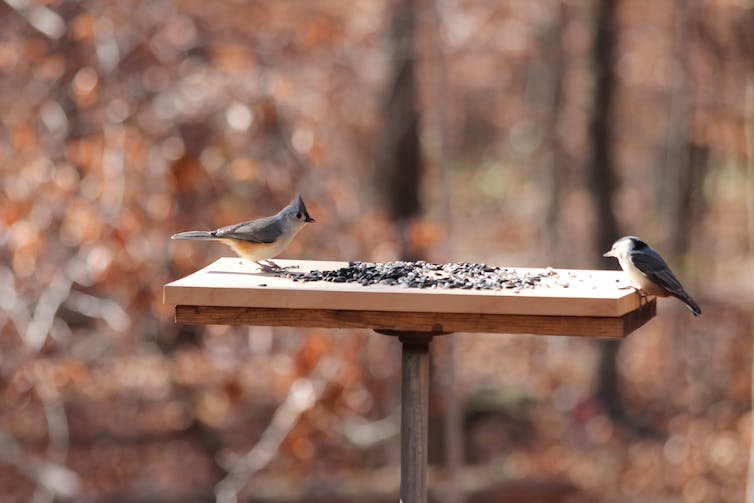Carolina chickadees are small, boisterous year-round residents of the southeastern United States. They are regularly found with much larger tufted titmice, white-breasted nuthatches and various woodpecker species.
In these mixed flocks, chickadees are almost always the subordinate individuals, outcompeted by their larger flockmates. Why, then, do chickadees regularly join these flocks? Might they have a symbiotic relationship with other species in these flocks?
I study animal behavior and am especially interested in testing how diverse groups of animals sometimes outperform uniform groups made up of a single species.
One potential explanation for why chickadees – or any species, for that matter – might join a mixed-species group is that such groups may possess a wider variety of cognitive tools, resulting in increased creativity and innovation for the group as a whole.
More is more
One of the first experiments to demonstrate the benefits of diversity involved honeybees and their ability to maintain optimal hive temperature, which is crucial to egg and larval development.
Scientists manipulated the surrounding temperature of bee colonies that varied in their genetic relatedness. Some colonies had only a single male that mated with the queen, while others had multiple males that mated with the queen. The more genetically diverse colonies were better at maintaining hive temperatures than the genetically alike colonies.
The benefits of diversity within a species appear to extend to mixed-species groups as well.
Scientists have shown that Caribbean zenaida doves benefit by being in groups with Carib grackles, a species of blackbird. Zenaida doves do not have alarm calls of their own but respond to the alarm calls of grackles with increased vigilance. Carib grackles, in turn, may gain foraging benefits from interactions with zenaida doves by copying their foraging behavior and movements.
Similarly, Diana monkeys and Campbell’s monkeys in Côte d’Ivoire regularly join up in mixed-species groups. When this occurs, both species are freed up by the greater number of eyes and ears scanning for trouble, enabling them to focus on other tasks. Diana monkeys forage more in mixed-species groups than when they are alone and Campbell’s monkeys move and call more than when they are alone.

Tufted titmouse, left, and white-breasted nuthatch eat from our platform feeder.
Todd M. Freeberg, CC BY-ND
Birds of different feathers also flock together
My colleagues and I found similar results in our research on Carolina chickadees. These birds are often found in flocks with tufted titmice and white-breasted nuthatches, as well as a handful of other occasional species. We have been studying these flocks for two decades using simple platform feeders as a starting point. Once we found that a flock was using our platform feeder, we cleared the seeds and put them in a hopper-style feeder the birds had never…
